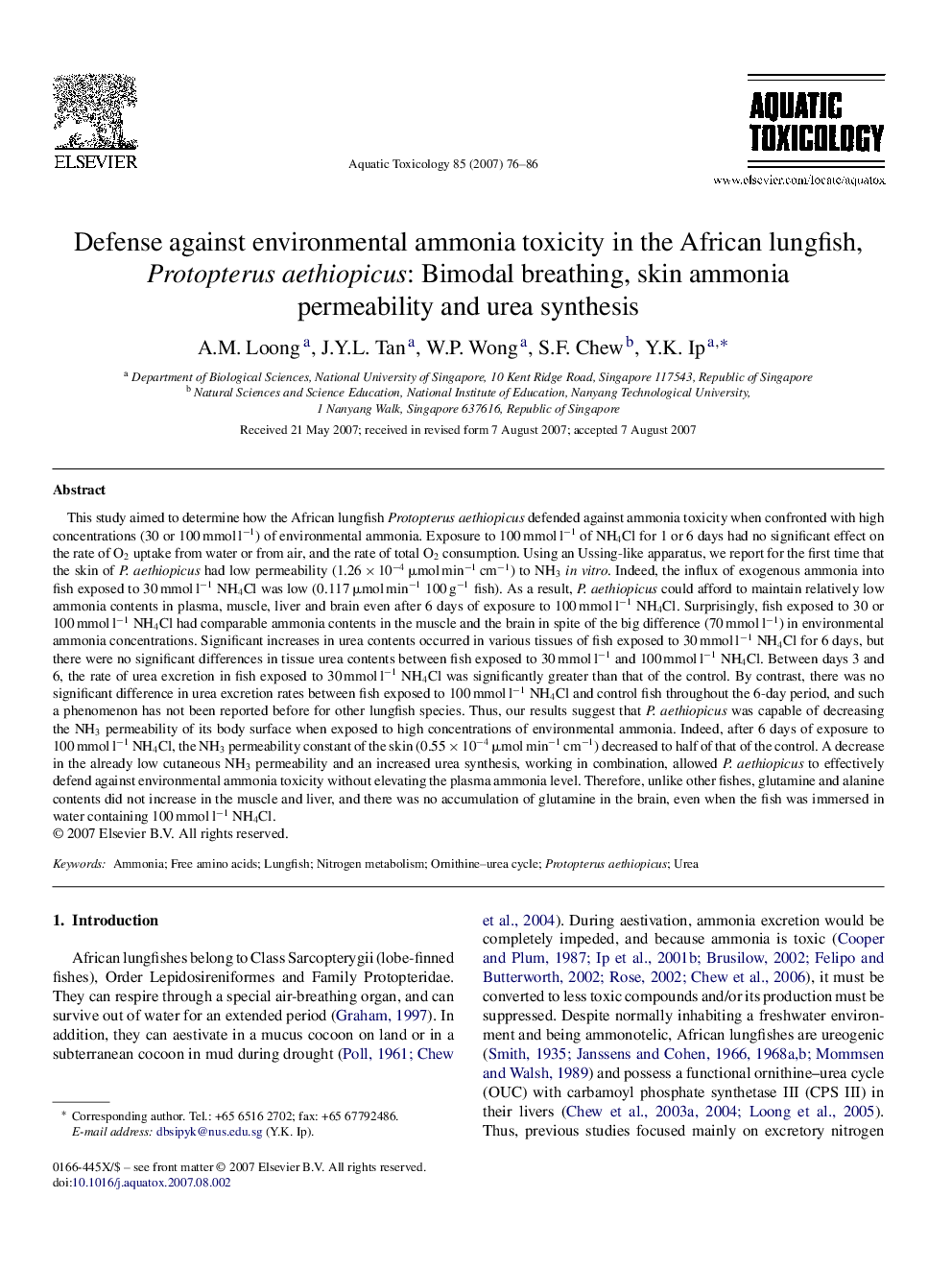| کد مقاله | کد نشریه | سال انتشار | مقاله انگلیسی | نسخه تمام متن |
|---|---|---|---|---|
| 4530868 | 1324735 | 2007 | 11 صفحه PDF | دانلود رایگان |
عنوان انگلیسی مقاله ISI
Defense against environmental ammonia toxicity in the African lungfish, Protopterus aethiopicus: Bimodal breathing, skin ammonia permeability and urea synthesis
دانلود مقاله + سفارش ترجمه
دانلود مقاله ISI انگلیسی
رایگان برای ایرانیان
کلمات کلیدی
موضوعات مرتبط
علوم زیستی و بیوفناوری
علوم کشاورزی و بیولوژیک
علوم آبزیان
پیش نمایش صفحه اول مقاله

چکیده انگلیسی
This study aimed to determine how the African lungfish Protopterus aethiopicus defended against ammonia toxicity when confronted with high concentrations (30 or 100 mmol lâ1) of environmental ammonia. Exposure to 100 mmol lâ1 of NH4Cl for 1 or 6 days had no significant effect on the rate of O2 uptake from water or from air, and the rate of total O2 consumption. Using an Ussing-like apparatus, we report for the first time that the skin of P. aethiopicus had low permeability (1.26 Ã 10â4 μmol minâ1 cmâ1) to NH3in vitro. Indeed, the influx of exogenous ammonia into fish exposed to 30 mmol lâ1 NH4Cl was low (0.117 μmol minâ1 100 gâ1 fish). As a result, P. aethiopicus could afford to maintain relatively low ammonia contents in plasma, muscle, liver and brain even after 6 days of exposure to 100 mmol lâ1 NH4Cl. Surprisingly, fish exposed to 30 or 100 mmol lâ1 NH4Cl had comparable ammonia contents in the muscle and the brain in spite of the big difference (70 mmol lâ1) in environmental ammonia concentrations. Significant increases in urea contents occurred in various tissues of fish exposed to 30 mmol lâ1 NH4Cl for 6 days, but there were no significant differences in tissue urea contents between fish exposed to 30 mmol lâ1 and 100 mmol lâ1 NH4Cl. Between days 3 and 6, the rate of urea excretion in fish exposed to 30 mmol lâ1 NH4Cl was significantly greater than that of the control. By contrast, there was no significant difference in urea excretion rates between fish exposed to 100 mmol lâ1 NH4Cl and control fish throughout the 6-day period, and such a phenomenon has not been reported before for other lungfish species. Thus, our results suggest that P. aethiopicus was capable of decreasing the NH3 permeability of its body surface when exposed to high concentrations of environmental ammonia. Indeed, after 6 days of exposure to 100 mmol lâ1 NH4Cl, the NH3 permeability constant of the skin (0.55 Ã 10â4 μmol minâ1 cmâ1) decreased to half of that of the control. A decrease in the already low cutaneous NH3 permeability and an increased urea synthesis, working in combination, allowed P. aethiopicus to effectively defend against environmental ammonia toxicity without elevating the plasma ammonia level. Therefore, unlike other fishes, glutamine and alanine contents did not increase in the muscle and liver, and there was no accumulation of glutamine in the brain, even when the fish was immersed in water containing 100 mmol lâ1 NH4Cl.
ناشر
Database: Elsevier - ScienceDirect (ساینس دایرکت)
Journal: Aquatic Toxicology - Volume 85, Issue 1, 15 November 2007, Pages 76-86
Journal: Aquatic Toxicology - Volume 85, Issue 1, 15 November 2007, Pages 76-86
نویسندگان
A.M. Loong, J.Y.L. Tan, W.P. Wong, S.F. Chew, Y.K. Ip,